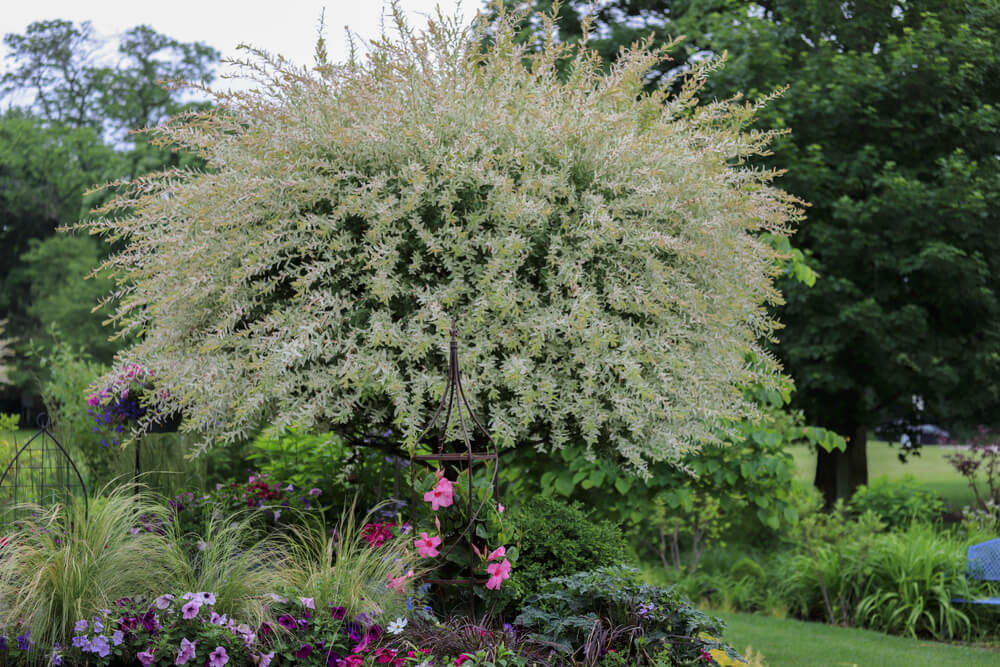17 Beautiful Pollinator Trees That Support Bees, Butterflies, And Wildlife!
Welcome! This article contains affiliate links, meaning I get a commission if you decide to make a purchase through my links, at no extra cost to you.
Want more backyard bees? Then grow some of these trees! While most gardeners focus on flower beds, trees are the secret weapons in supporting pollinators. One mature tree delivers massive quantities of nectar and pollen right at canopy level. They create buzzing super highways of pollinator activity that native bees, bumblebees, butterflies, and beneficial insects can’t resist!
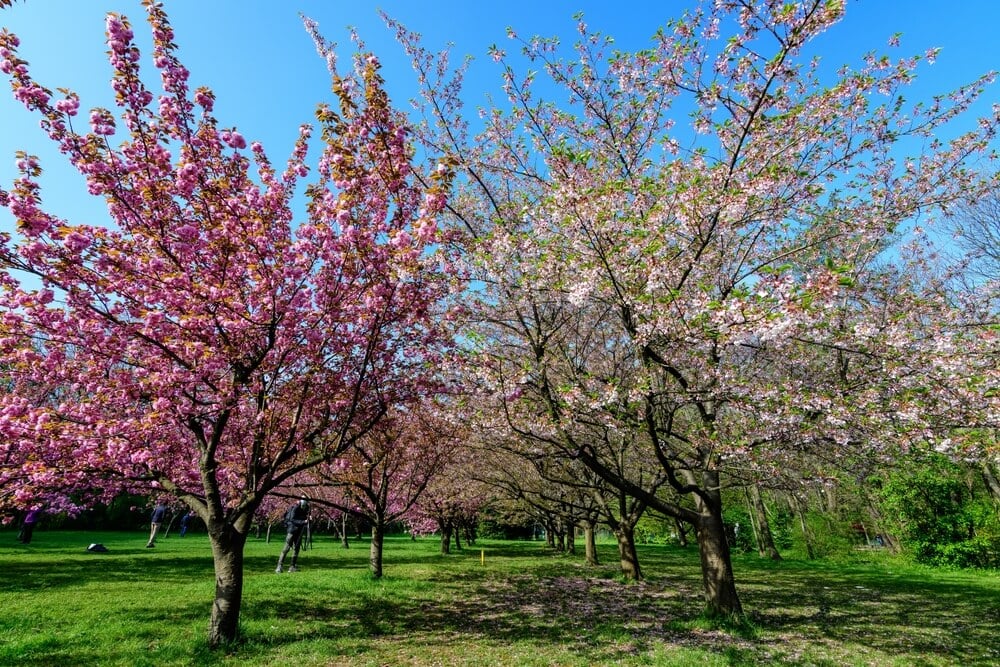
Sound intriguing?
Then let’s plant some gorgeous, floriferous trees that bees and their friends love to visit!
Best Pollinator Trees That Attract Bees And Wildlife
Here are the top pollinator trees that benefit backyard bees, butterflies, beneficial bugs, and wildlife!
1. Red Maple (Acer rubrum)
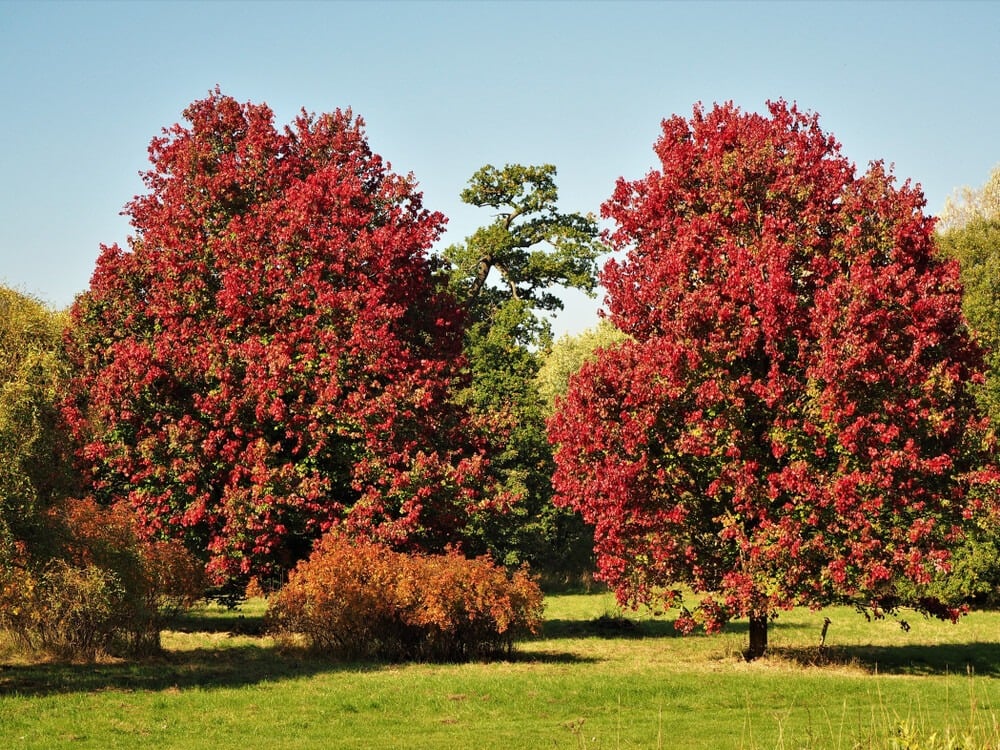
The red maple is a heavy-hitting pollinator champion, as it is one of the first trees to bloom each spring. Its tiny red flowers might not look like much from a distance. But up close, they’re buzzing with activity as hungry bees collect precious early-season nectar and pollen. This fast-growing native can reach impressive heights and reward you twice, once in spring with its pollinator feast, and again in fall when its leaves turn brilliant scarlet, orange, and yellow.
- USDA Grow Zones: 3 to 9.
- Bloom Season: Early spring (February to April).
- Bloom Color / Form: Small red to yellow clustered flowers appearing before leaves.
- Tree Size: Roughly 40 to 60 feet tall. 25 to 45 feet wide.
- Wildlife Benefits: Attracts honeybees, native bees, and various types of flies. The seeds feed birds and squirrels.
Red maples are particularly valuable for homesteaders because they thrive in wet areas where other trees struggle. It’s perfect for any soggy areas in your yard.
2. Black Gum/Tupelo (Nyssa sylvatica)
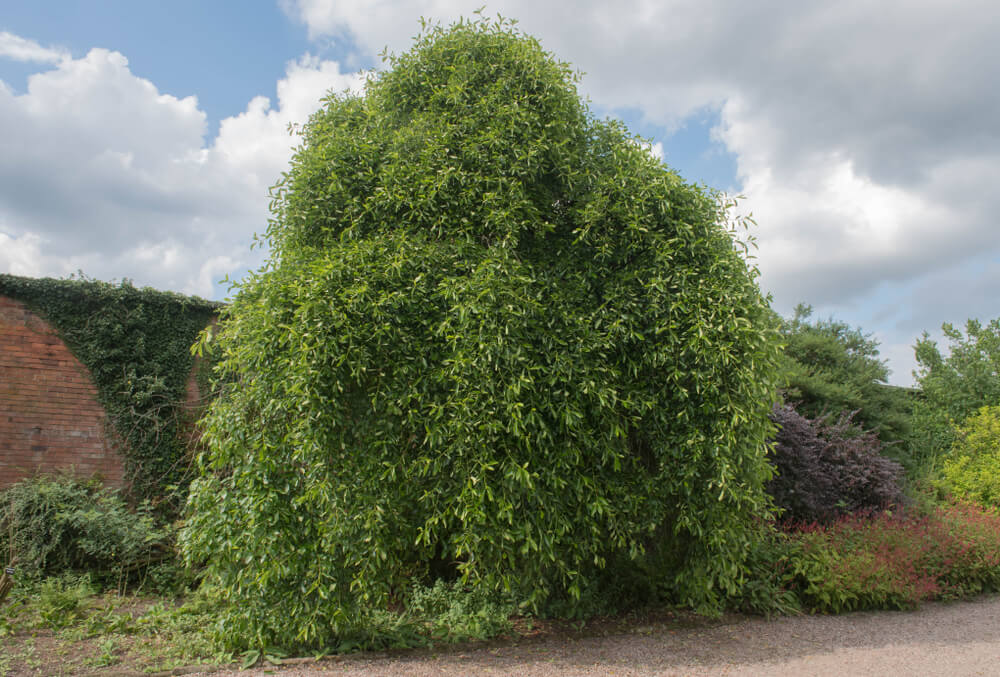
Black Gum, also known as Tupelo, is a hidden gem among pollinator trees. When this stately native blooms in late spring, its small greenish-white flowers may seem modest, but they produce some of the most prized honey in North America. Beyond its pollinator value, Black Gum offers unmatched fall color – brilliant scarlet, orange, and yellow leaves that rival any maple.
- USDA Grow Zones: 4 to 9.
- Bloom Season: Late spring (May to June).
- Bloom Color / Form: Small greenish-white flowers in clusters. Male and female buds on separate trees.
- Tree Size: Roughly 50 to 80 feet tall by 20 to 30 feet wide.
- Wildlife Benefits: Attracts honeybees (produces premium honey), native bees, and flies. The dark blue berries feed over 35 bird species, and the tree serves as a host for several butterfly species.
Black Gum thrives in both wet and well-drained soils, making it an incredibly adaptable species. Its dense wood and distinctive blocky bark add winter interest, while its early fall color provides a stunning autumn display when most trees are still green.
3. Eastern Redbud (Cercis canadensis)
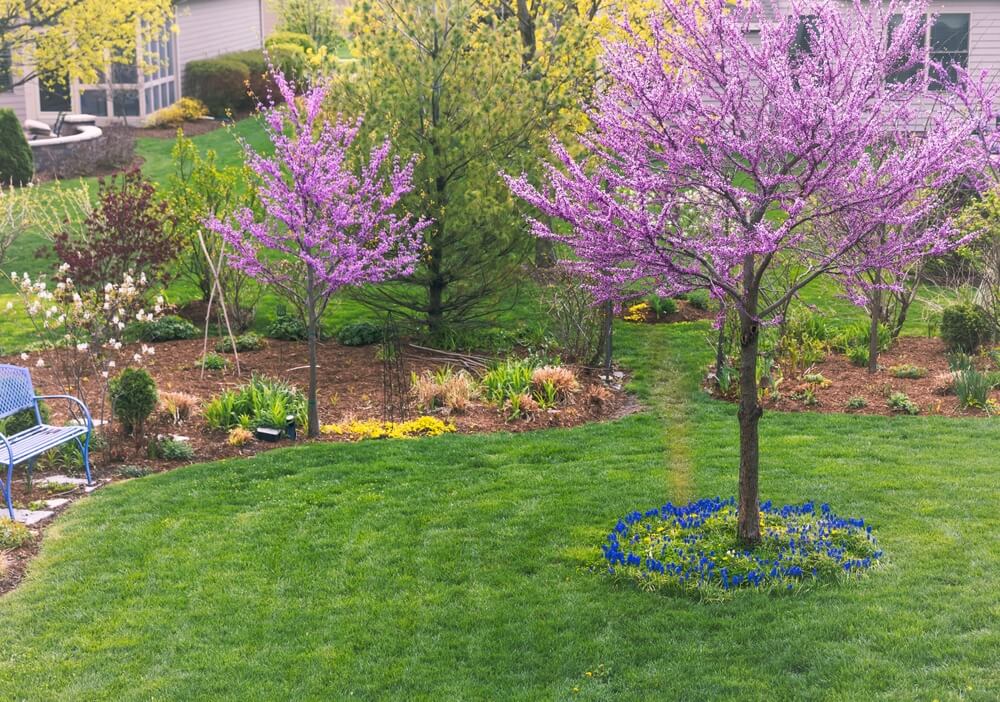
Blooming Eastern redbud trees are gorgeous. Its branches appear covered in magenta-pink flowers, seemingly emerging directly from the bark! This phenomenon, known as “cauliflory,” gives the tree a majestic appearance. Bees also adore these lovely blooms. Its heart-shaped leaves create a beautiful dappled shade throughout the summer.
- USDA Grow Zones: 4 to 9.
- Bloom Season: Early spring (March to May).
- Bloom Color / Form: Magenta-pink pea-like flowers blooming directly on branches and trunk.
- Tree Size: Roughly 20 to 30 feet tall by 25 to 35 feet wide.
- Wildlife Benefits: Attracts honeybees, bumblebees, native bees, and butterflies. Serves as a host plant for Henry’s Elfin butterfly.
Native Americans traditionally ate the flowers, and you can too. They have a mild, sweet flavor that’s perfect for salads or as an edible garnish.
4. Serviceberry (Amelanchier spp.)
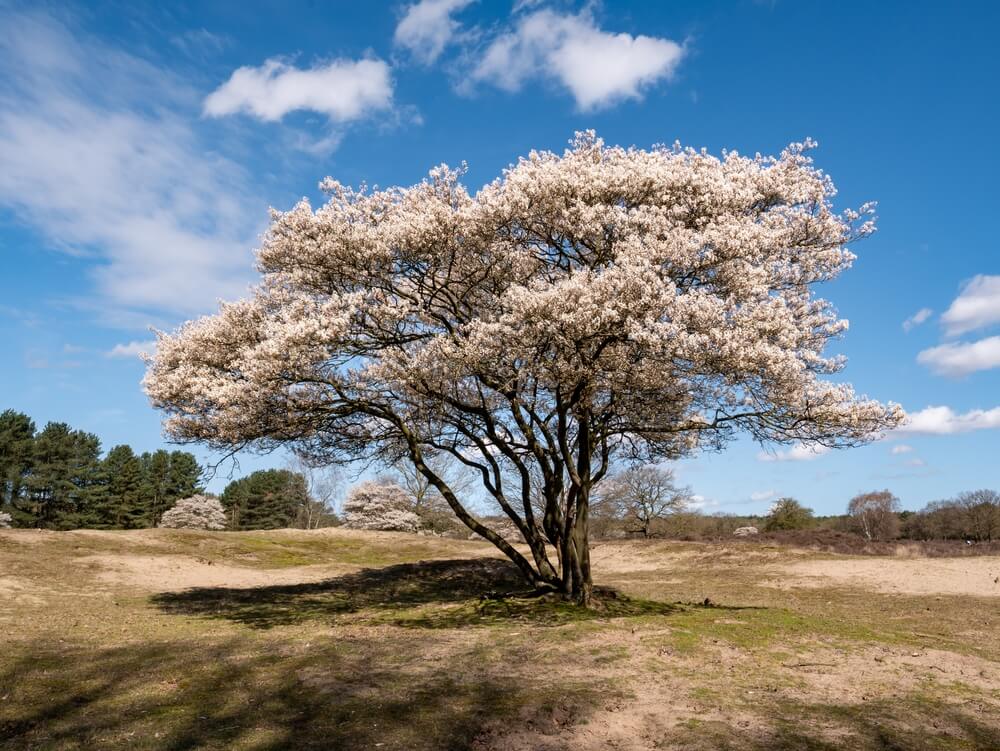
Also known as Juneberry or Shadbush (because it blooms when the shad fish run upstream), serviceberry is truly a multi-season superstar. Its delicate white flowers create clouds of bee activity in early spring, followed by sweet, blueberry-like fruits that humans, birds, and wildlife adore. The berries are fantastic for pies, jams, or eating fresh off the tree.
- USDA Grow Zones: 2 to 9 (varies by species).
- Bloom Season: Early spring (March to May).
- Bloom Color / Form: Delicate white 5-petaled flowers in drooping clusters.
- Tree Size: Roughly 15 to 25 feet tall by 10 to 20 feet wide.
- Wildlife Benefits: Attracts honeybees, native bees, and butterflies. The berries support a wide range of bird species, small mammals, and deer.
This adaptable native thrives in various conditions and provides stunning fall color, making it an excellent choice for edible landscaping enthusiasts who want to feed both pollinators and their families.
Read More – 21 Incredible + Edible Shrubs That Produce Yummy And Sweet Fruit Without Fuss!
5. Willow (Salix spp.)
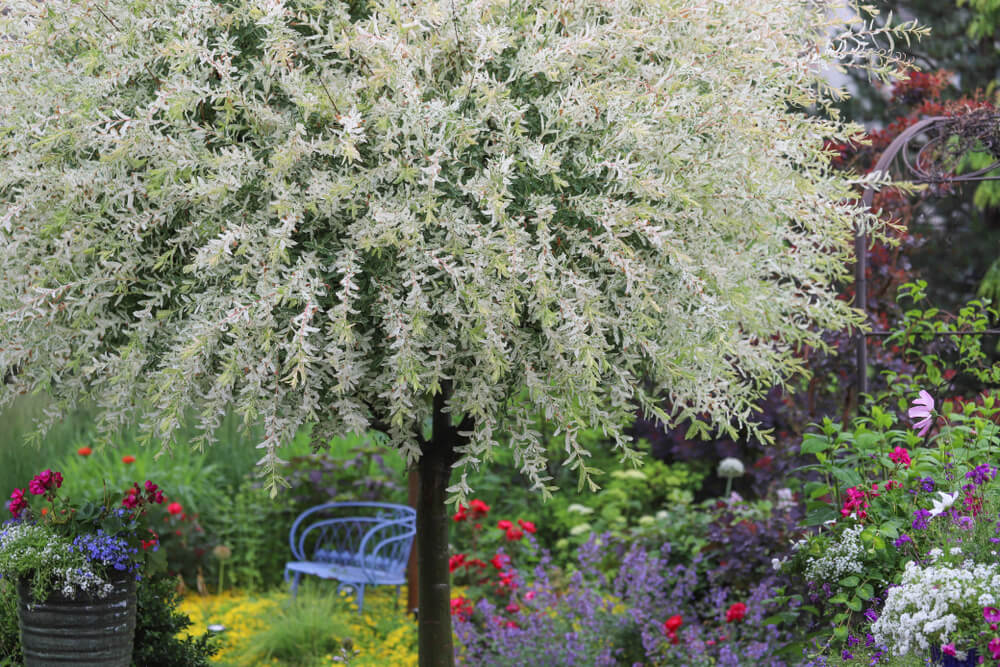
Willows, particularly pussy willow and black willow, offer superb early-season pollinator support. Their fuzzy catkins might look simple. However, they’re loaded with pollen and nectar, providing nourishing food sources when little else is available. Male willows are especially valuable for pollen, while female trees offer nectar.
- USDA Grow Zones: 2 to 9 (varies by species).
- Bloom Season: Early spring (February to April).
- Bloom Color / Form: Fuzzy gray catkins (male) turning yellow with pollen. Female catkins are smaller and green.
- Tree Size: Roughly 30 to 50 feet tall by 30 to 40 feet wide (varies widely by species).
- Wildlife Benefits: Attracts honeybees, native bees, and butterflies.
They’re also instrumental. The flexible branches have been used for basket weaving for centuries, and the inner bark has traditional medicinal uses.
6. Cherry Trees (Prunus spp.)
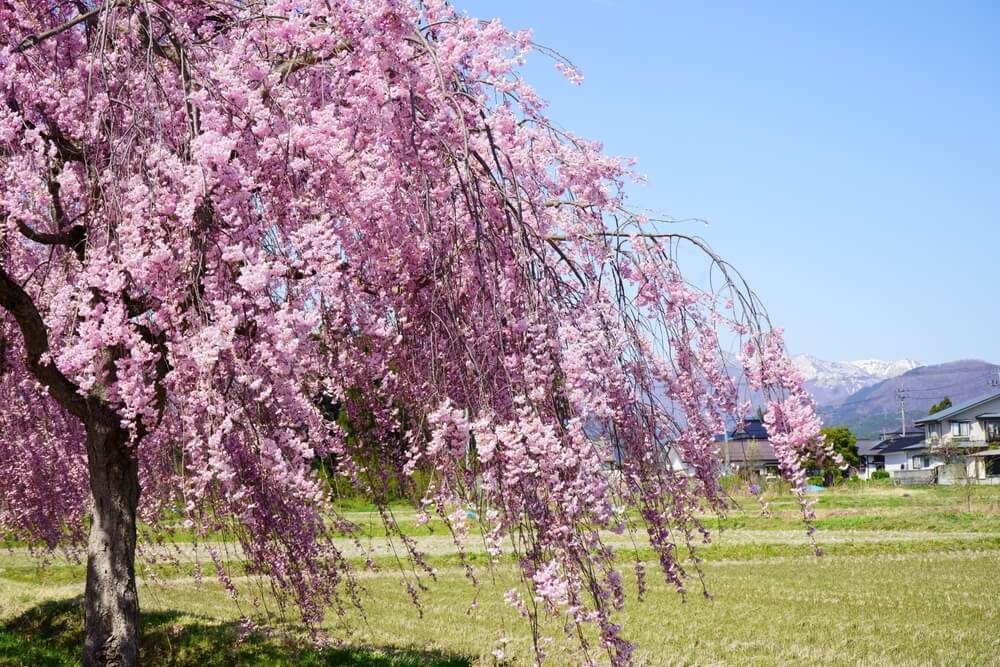
Native cherries, such as Black Cherry, create some of spring’s most spectacular pollinator celebrations. When these trees bloom, they transform into clouds of fragrant, white flowers that attract not just bees, but also butterflies, beneficial wasps, and other pollinators in large numbers.
- USDA Grow Zones: 3 to 9 (varies by species).
- Bloom Season: Mid to late spring (April to May).
- Bloom Color / Form: White fragrant flowers in drooping clusters or flat-topped clusters.
- Tree Size: Roughly 20 to 60 feet tall by 15 to 30 feet wide.
- Wildlife Benefits: Attracts honeybees, native bees, butterflies, birds, and beneficial wasps.
Black Cherry can grow quite large and produces small cherries that birds love. Smaller species, like American Plum, fit perfectly into compact landscapes.
7. Crabapple (Malus spp.)
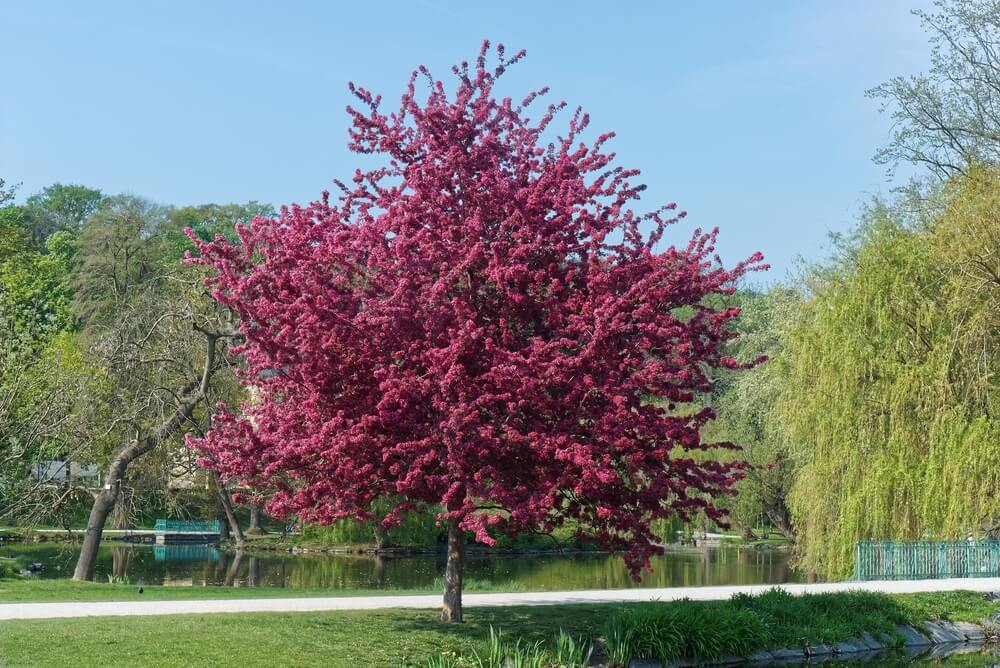
Want a pollinator spectacle? Plant a crabapple tree. Their abundant flowers, in shades of white, pink, and deep rose, create a stunning display while producing enough nectar and pollen to support entire bee colonies. The fragrance is intoxicating. Sweet and fruity with hints of honey. The small fruits that follow feed dozens of bird species throughout fall and winter, making your landscape a year-round wildlife haven.
- USDA Grow Zones: 3 to 8.
- Bloom Season: Mid to late spring (April to May).
- Bloom Color / Form: Showy 5-petaled flowers in white, pink, or deep rose, appearing in clusters.
- Tree Size: Roughly 15 to 25 feet tall by 15 to 25 feet wide.
- Wildlife Benefits: Attracts honeybees, bumblebees, native bees, and butterflies. The small fruits provide food for many bird species.
Select disease-resistant varieties for optimal long-term success, and don’t worry about the fallen fruit. It’s biodegradable garden gold that feeds soil organisms.
Read More – 26 Lovely Garden Themes For Growing In Your Backyard – From Whimsical To Wild!
8. American Basswood (Tilia americana)
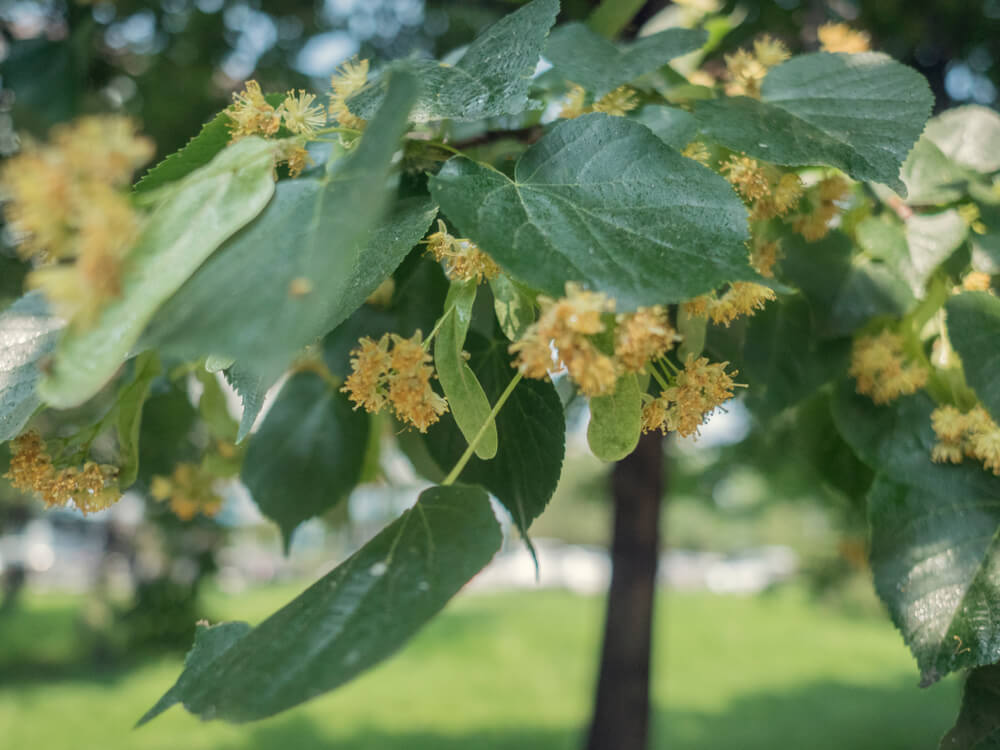
Known as the “bee tree,” American Basswood is legendary among beekeepers for producing some of the finest honey in North America. When this majestic shade tree blooms in late spring or early summer, the fragrance is so intense you can smell it from blocks away. It’s a sweet, intoxicating perfume that signals to every bee within miles that dinner is served.
- USDA Grow Zones: 2 to 8.
- Bloom Season: Early summer (June to July).
- Bloom Color / Form: Small, creamy white, fragrant flowers in drooping clusters with papery bracts.
- Tree Size: Roughly 60 to 80 feet tall by 30 to 50 feet wide.
- Wildlife Benefits: Attracts honeybees (produces premium honey), bumblebees, and native bees. The seeds feed birds and squirrels.
The American Basswood is an excellent tree for its ability to support vast pollinator populations while providing ample, cooling shade and beautiful, heart-shaped leaves.
9. Tulip Tree (Liriodendron tulipifera)
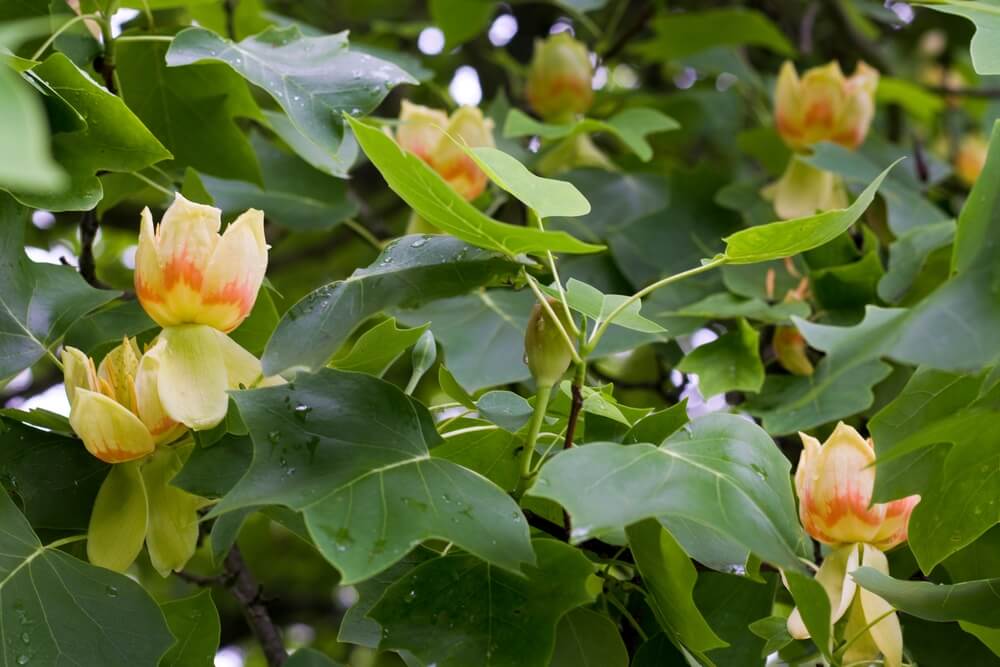
The tulip tree is nature’s skyscraper! It can easily reach 100 feet or more. It also has unique tulip-shaped flowers that are architectural marvels in their own right. The orange and yellow blooms, marked with distinctive patterns, produce copious nectar that attracts both bees and ruby-throated hummingbirds.
- USDA Grow Zones: 4 to 9.
- Bloom Season: Late spring to early summer (May to June).
- Bloom Color / Form: Large tulip-shaped flowers, greenish-yellow with orange markings.
- Tree Size: Roughly 70 to 100 feet tall. Around 30 to 50 feet wide.
- Wildlife Benefits: Attracts honeybees, native bees, butterflies, and hummingbirds.
Tulip trees have gorgeous wood that’s popular for construction. But its real value lies in those magnificent flowers that bloom high in the canopy.
10. Black Locust (Robinia pseudoacacia)
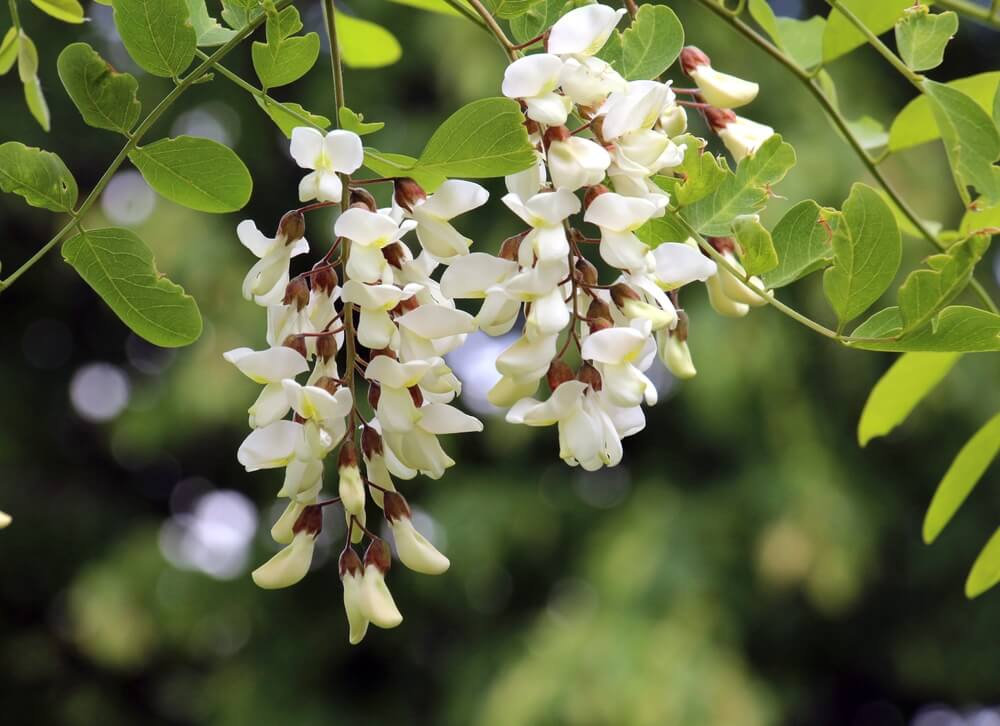
Don’t let the thorns fool you! Black locust is a pollinator powerhouse that produces some of the most fragrant flowers in the tree world. The drooping clusters of white, pea-like flowers smell like orange blossoms and are irresistible to honeybees, often producing surplus honey even in challenging years. This incredibly hardy tree also thrives in poor soils, fixes nitrogen like other legumes, and grows rapidly.
- USDA Grow Zones: 3 to 8.
- Bloom Season: Late spring (May to June).
- Bloom Color / Form: Drooping clusters of white, fragrant pea-like flowers.
- Tree Size: Roughly 30 to 50 feet tall by 20 to 35 feet wide.
- Wildlife Benefits: Attracts honeybees (major honey producer) and native bees. The seeds feed birds, and deer browse the foliage.
The wood is naturally rot-resistant, prized for use in fence posts and outdoor projects, providing both beautiful blooms and practical timber.
Read More – 15 Dazzling Perennial Flowers That Rebloom Multiple Times Each Year!
11. Sourwood (Oxydendrum arboreum)
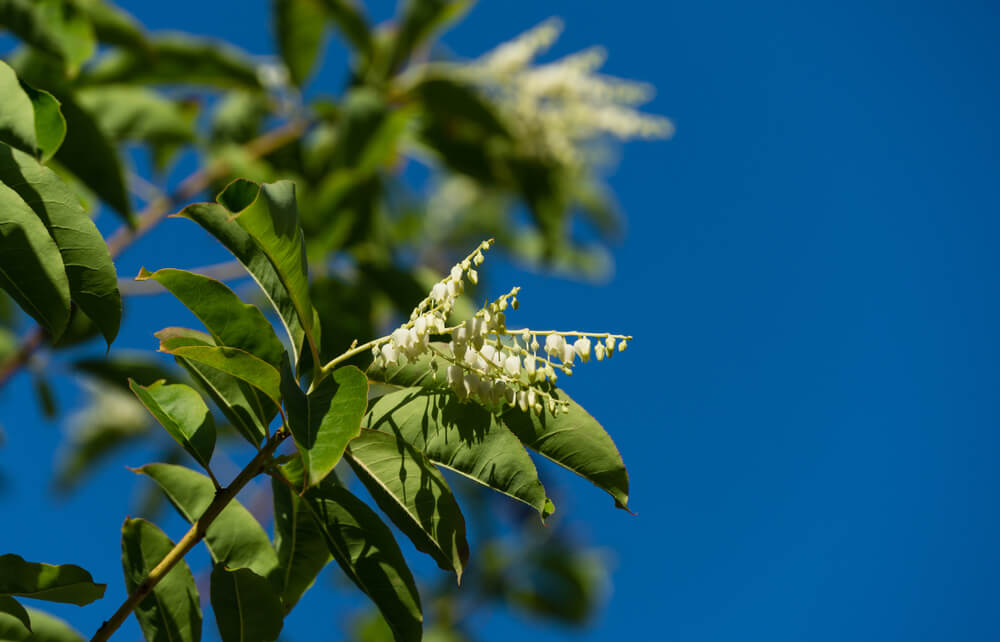
Sourwood is the aristocrat of pollinator trees, producing some of the most prized honey in the southeastern United States. Its bell-shaped white flowers hang in graceful clusters like lily-of-the-valley, blooming in midsummer when many other nectar sources have faded. The honey from sourwood is so distinctive and delicious that it commands premium prices.
- USDA Grow Zones: 5 to 9.
- Bloom Season: Mid to late summer (June to August).
- Bloom Color / Form: Small, white bell-shaped flowers in drooping clusters.
- Tree Size: Roughly 25 to 30 feet tall by 15 to 25 feet wide.
- Wildlife Benefits: Attracts honeybees (produces gourmet honey) and native bees. The seeds feed birds.
Beyond its pollinator value, sourwood offers spectacular fall color, featuring brilliant scarlet and orange hues that rival those of any maple. It also has attractive, deeply grooved bark that provides winter interest.
12. Dogwood (Cornus florida)
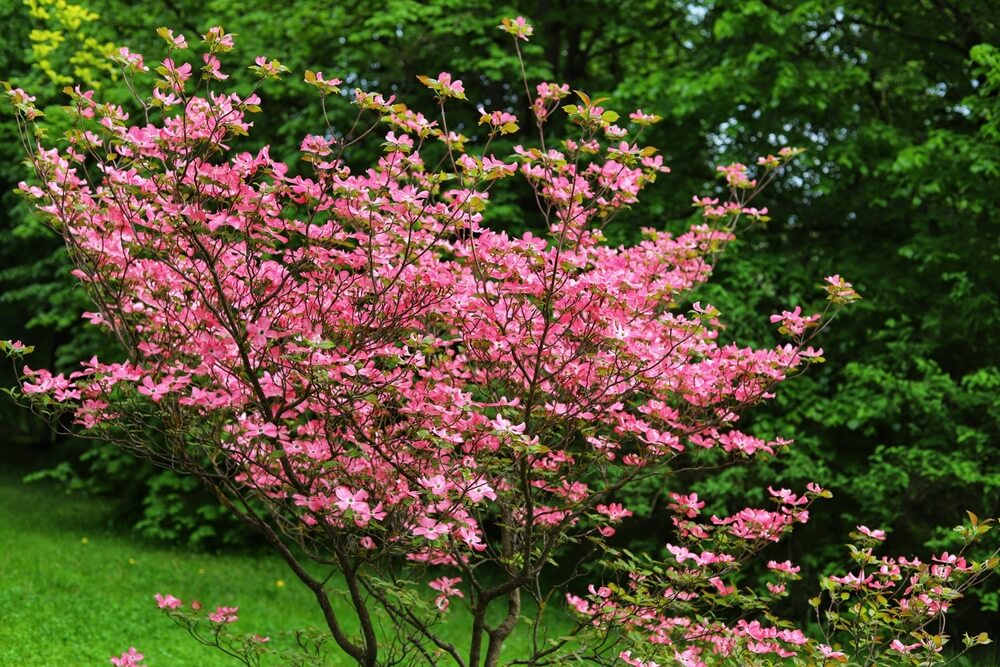
The classic flowering dogwood is beloved for its iconic spring beauty and also for its crucial role in supporting pollinators and wildlife. What most people think of as “petals” are bracts that surround clusters of small, inconspicuous flowers, and those little flowers are goldmines of nectar and pollen.
- USDA Grow Zones: 5 to 9.
- Bloom Season: Mid to late spring (April to May).
- Bloom Color / Form: Small greenish-yellow flowers surrounded by large white (or pink) bracts.
- Tree Size: Roughly 15 to 30 feet tall by 15 to 30 feet wide.
- Wildlife Benefits: Attracts honeybees, native bees, and butterflies. The berries feed 35+ bird species.
Dogwood trees are understory trees that thrive in partial shade. They’re perfect for woodland gardens or any areas under larger trees.
13. Magnolia (Magnolia spp.)
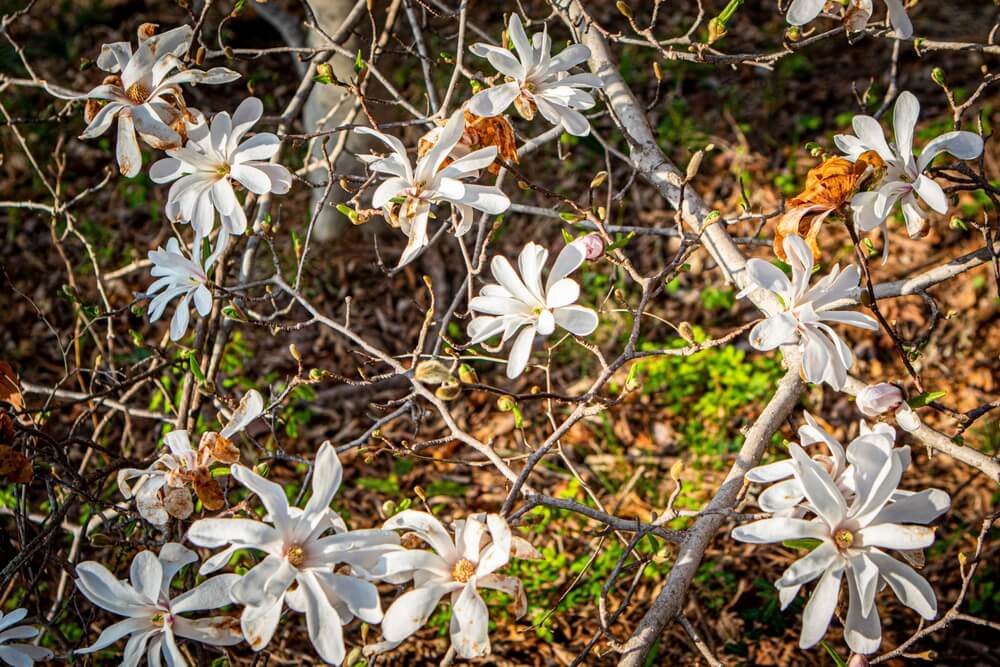
Magnolias have gorgeous, large, fragrant flowers that are marvels of evolution. They were designed initially to attract beetles but are also welcoming to bees and other insects. Sweetbay Magnolia is particularly valuable for northern gardeners, as it extends the magnolia experience into colder climates while providing glossy, evergreen-to-semi-evergreen foliage and intensely fragrant white flowers.
- USDA Grow Zones: 5 to 10 (varies by species; Sweetbay 5 to 9).
- Bloom Season: Late spring to early summer (May to July, depending on the species).
- Bloom Color / Form: Large, fragrant white, pink, or purple flowers with multiple petals.
- Tree Size: Roughly 20 to 80 feet tall by 20 to 40 feet wide (depending on species).
- Wildlife Benefits: Attracts bees, beetles, and flies. Birds and small mammals also love the seeds.
The blooms are so fragrant that they can perfume an entire yard, creating an almost tropical atmosphere in temperate gardens.
Read More – 14 Epic Fruit Trees For Growing In Containers And Pots – Even On A Balcony Or Porch!
14. American Holly (Ilex opaca)
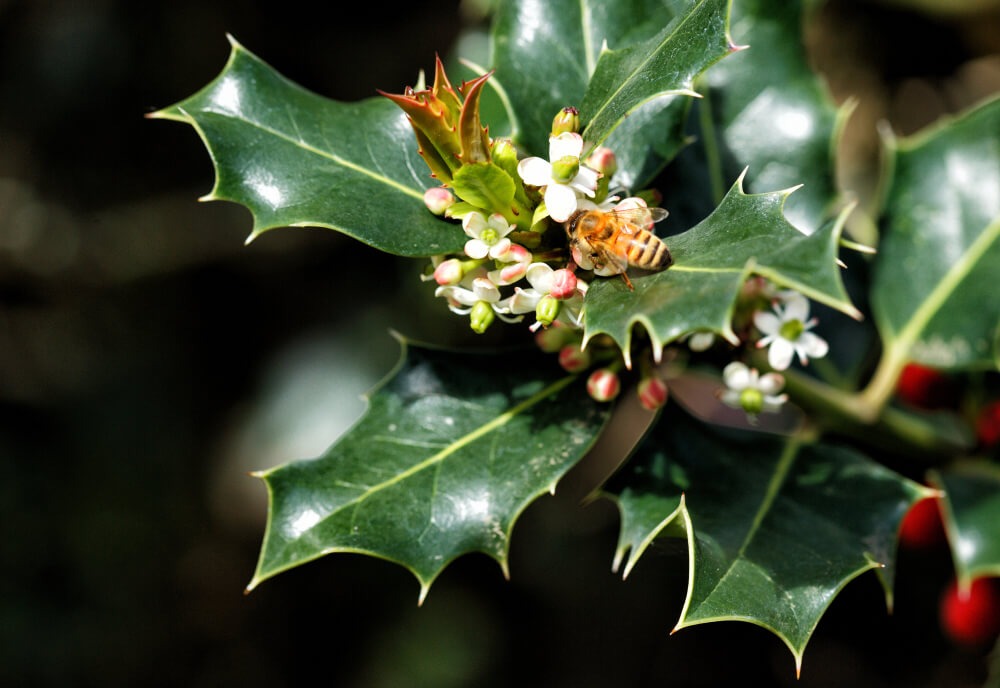
This evergreen beauty proves that pollinator flowers don’t always have to be showy to be effective. American Holly’s small, white flowers are inconspicuous but incredibly sweet-smelling, attracting a diverse array of native bees and other insects in late spring. Female trees produce the iconic bright red berries that feed birds throughout winter, but you’ll need both male and female trees for berry production.
- USDA Grow Zones: 5 to 9.
- Bloom Season: Late spring (May to June).
- Bloom Color / Form: Small, white 4-petaled flowers in clusters.
- Tree Size: Roughly 15 to 30 feet tall by 15 to 25 feet wide.
- Wildlife Benefits: Attracts native bees, honeybees, and flies. The berries support over 15 bird species, and they also provide nesting sites.
The dense, spiny foliage provides excellent nesting sites and winter shelter for birds, making this tree a year-round haven for wildlife, particularly valuable in urban settings.
15. American Plum (Prunus americana)
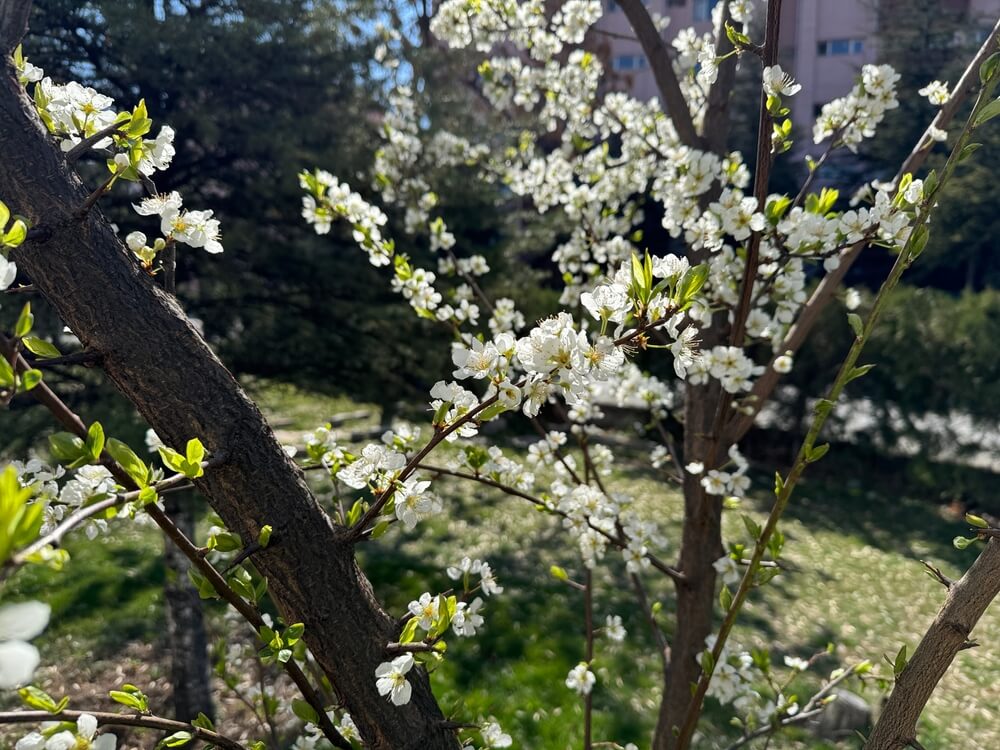
This scrappy native forms beautiful thickets of fragrant white flowers in early spring, creating natural pollinator corridors that support bee highways across the landscape. The sweet-tart plums that follow are excellent for jams, jellies, and fresh eating, if you can beat the birds to them!
- USDA Grow Zones: 3 to 8.
- Bloom Season: Early spring (March to April).
- Bloom Color / Form: Fragrant white 5-petaled flowers in clusters.
- Tree Size: Roughly 10 to 25 feet tall by 10 to 20 feet wide.
- Wildlife Benefits: Attracts honeybees, native bees, and butterflies. The plums feed birds and mammals.
Its suckering habit creates natural windbreaks and erosion control, making it particularly valuable for homesteaders dealing with challenging sites.
16. Hawthorn (Crataegus spp.)
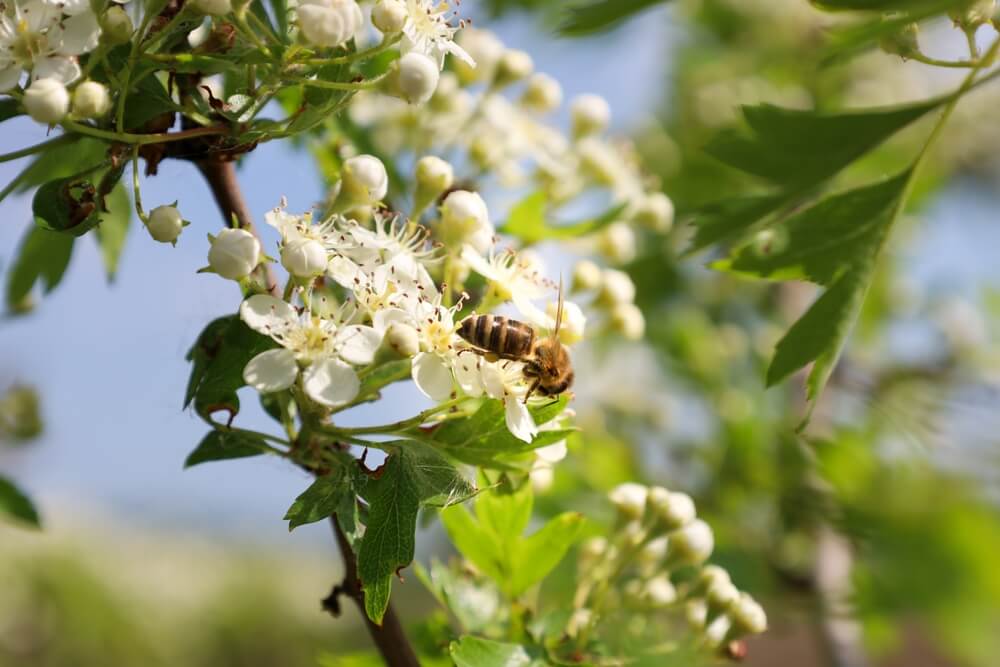
Hawthorn trees might be thorny. However, they’re elite pollinator magnets! They have clusters of white or pink flowers that seem to buzz with constant activity. And the small fruits feed countless birds through fall and winter. The flowers have a unique, somewhat musky fragrance that some find objectionable, but pollinators find irresistible.
- USDA Grow Zones: 3 to 9 (varies by species).
- Bloom Season: Late spring (May to June).
- Bloom Color / Form: White or pink flowers in flat-topped clusters.
- Tree Size: Roughly 15 to 30 feet tall by 15 to 25 feet wide.
- Wildlife Benefits: Attracts honeybees, native bees, and butterflies. Serves as a host plant for 150+ species. The berries feed birds.
For homesteaders, hawthorns make excellent security hedges while providing food and habitat.
Read More – The Ultimate Guide To Buff Orpington Chickens! – England’s Golden Gift To Backyard Chicken Keepers!
17. Chokecherry (Prunus virginiana)
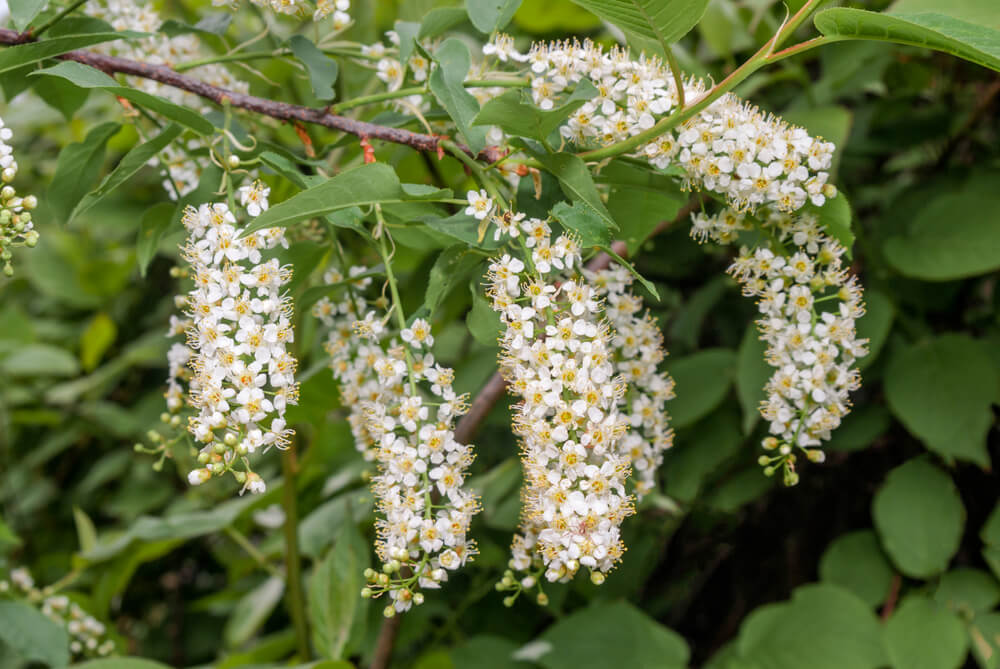
Don’t let the name scare you. While the berries are astringent when fresh, they make excellent jellies, syrups, and traditional pemmican. The real star is the abundant white flower clusters that appear in late spring. They create a spectacular show that attracts bees, butterflies, and beneficial insects by the hundreds.
- USDA Grow Zones: 2 to 7.
- Bloom Season: Late spring (May to June).
- Bloom Color / Form: White flowers in dense, elongated clusters.
- Tree Size: Roughly 20 to 30 feet tall by 15 to 25 feet wide.
- Wildlife Benefits: Attracts honeybees, native bees, and butterflies. The berries feed 40+ bird species.
Birds love the dark purple fruits. They can often strip trees clean within days of ripening!
Read More – How To Grow Pole And Bush Beans In Your Backyard – From Seed To Delicious Harvest!
Conclusion
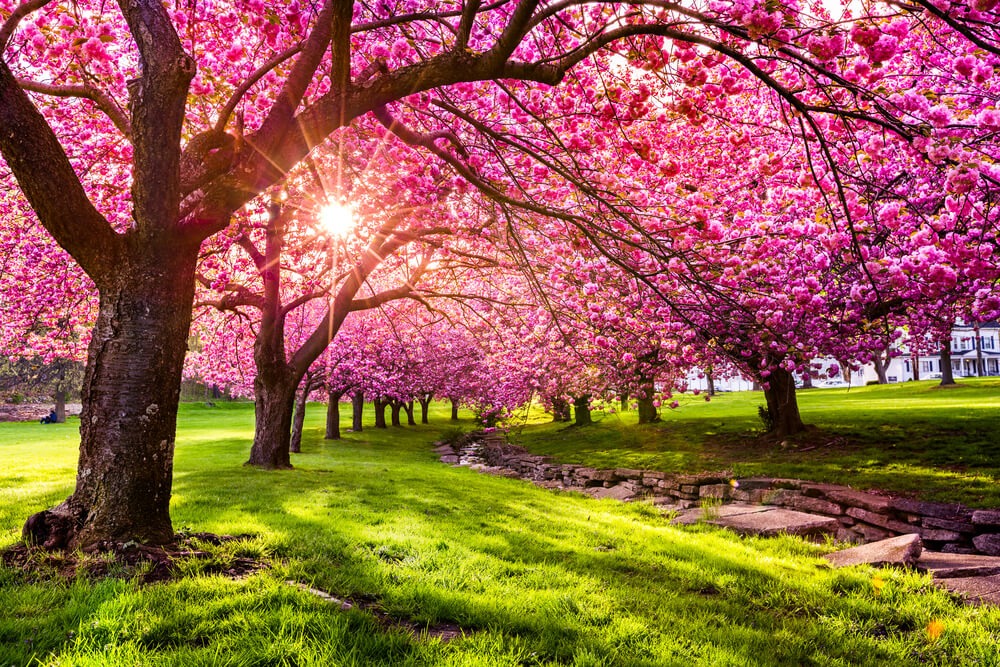
Remember that these create entire ecosystems that support birds, beneficial insects, and wildlife while providing you with beauty, shade, and often food. Many offer the bonus of gorgeous fall color, interesting bark, or winter berries that extend their value throughout the year.
What about you??
- Have you noticed a decline in pollinators around your home?
- Will you grow some pollinator trees this year?
- What pollinator tree species will you grow?
Thanks for reading.
Have a great day!

